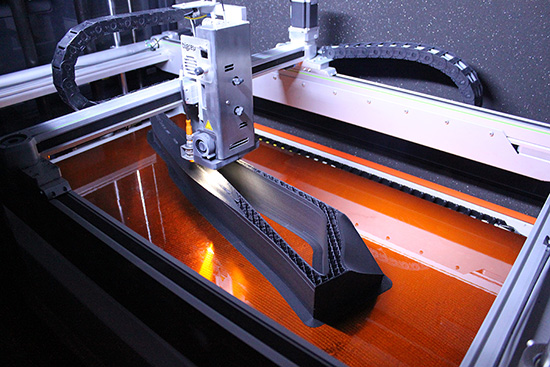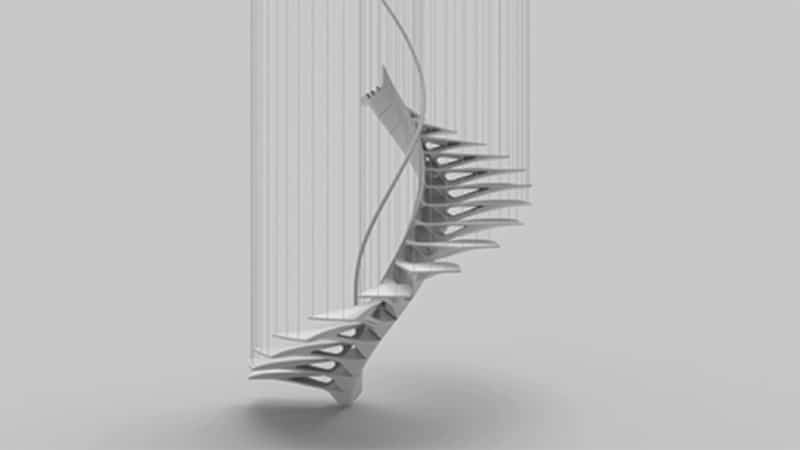Large-format 3D printer manufacturer BigRep and BASF’s additive manufacturing arm Forward AM have launched a new architecture-oriented 3D printing material.
Appropriately named ‘Concrete Formwork,’ the firms’ PET filament is designed to enable the creation of complex supports for precast concrete, at lower costs and lead times than normal building methods allow. Using BigRep’s STUDIO G2 3D printer and their new polymer, the companies are already planning to construct a unique concrete staircase, to showcase the material’s design and efficiency potential.
“We are excited to work with Forward AM to bring more solutions to the architecture and construction industry,” said Dr. Sven Thate, Managing Director of BigRep. “Our customers are seeing huge gains in terms of cost and speed thanks to our large-format machines and the new Concrete Formwork filament. Our solutions are opening the doors to many new possibilities.”
Developing future-proof architecture
As modern architects continue to come up with novel, innovative and ultimately demanding designs, it’s becoming increasingly difficult to reinforce their complicated creations effectively. Usually, formworks are used to temporarily support the building of such concrete structures, but as creatives have grown more ambitious, normal methods of reinforcement are becoming unable to cope.
In order to enable the construction of more advanced concrete molds, BigRep and Forward AM have therefore extended their existing partnership, to develop and launch their Concrete Formwork filament. Designed specifically for use with BigRep’s G2 machines, the new material is said to be characterized by high stability, low moisture absorption and resistance to temperatures of up to 100 °C.
According to the BigRep and Forward AM, building conventional formwork requires the contribution of highly-skilled workers, which can drive the process’ price up to 60% of a build’s total budget. By contrast, using their Concrete Formwork, the firms say that it’s now possible to create casts with organic geometries, double-curved surfaces and even cavities, at a “fraction of the cost.”

‘Design-to-production’ 3D printing
In addition to co-developing their new filament, BigRep and Forward AM have combined their expertise in virtual engineering and 3D printing to create a ‘digital design-to-production’ process. Within the firms’ concrete casting workflow, formwork can be seamlessly designed, additive manufactured, deployed and reused, potentially enabling adopters to significantly reduce their material waste.
Leveraging the companies’ approach, it’s also possible to scan and 3D print highly-accurate replicas to aid the restoration of old buildings, and if users require formwork that’s larger than the G2’s build volume, they can just produce it in pieces before assembling, post-processing and placing it alongside ordinary supports.
Since developing their new workflow, Forward AM and BigRep have also begun working with ETH Zurich’s DBT, ROK, SW Umwelttechnik and WaltGalmarini, to precast a set of concrete stairs. Nicknamed ‘Nest Step2,’ the upcoming architectural element is being built to exhibit the circular credentials of digital construction, and its steps are set to be 50% lighter than regular concrete, giving them a reduced carbon footprint.
Construction firm Geiger, meanwhile, has put Concrete Formwork into practise, using it to 3D print supports that have expedited the restoration of a building’s five meter-tall window frames. Elsewhere, the new material has been deployed to reinforce the builds of everything from outdoor sculptures to sensor-embedded walls, proving its efficacy in supporting a wide variety of highly-customized concrete structures.

Large-format concrete 3D printing
The introduction of digital design within the construction industry is increasingly providing manufacturers with a means of building bigger, bolder and more ambitious concepts than before. Just last month, a team of BAM and Weber Beamix engineers started to build the world’s longest 3D printed concrete pedestrian bridge in the Netherlands.
Designed by Michiel van der Kley and the Eindhoven University of Technology, the 97-foot structure is being built freeform, in a way that would be impossible to achieve with traditional formwork-based techniques. In Italy, meanwhile, researchers at the University of Messina have developed a lightweight foamed concrete, that could be used to 3D print structures without the need for any formwork whatsoever.
In more end-use applications, formwork and scaffolding system supplier PERI is currently using Danish manufacturing firm COBOD’s large-format systems to construct a commercial apartment building in Germany. Once finished, the three-floor structure is set to be listed on the local housing market as five separate rentable apartments.
To stay up to date with the latest 3D printing news, don’t forget to subscribe to the 3D Printing Industry newsletter or follow us on Twitter or liking our page on Facebook.
Are you looking for a job in the additive manufacturing industry? Visit 3D Printing Jobs for a selection of roles in the industry.
Featured image shows a piece of staircase formwork being 3D printed on BigRep’s Studio G2 3D printer. Image via Forward AM.



